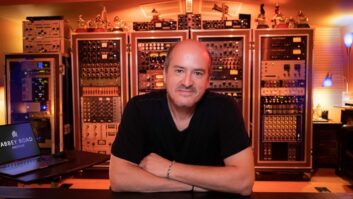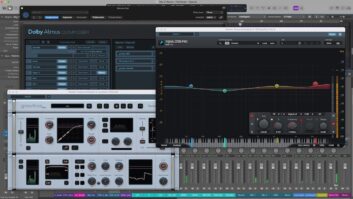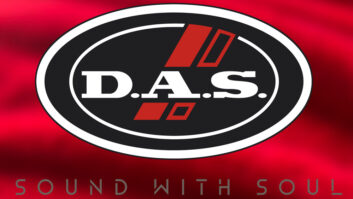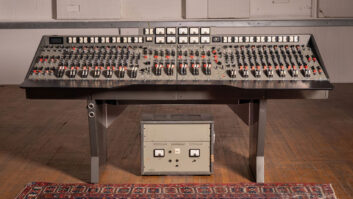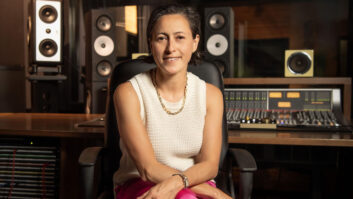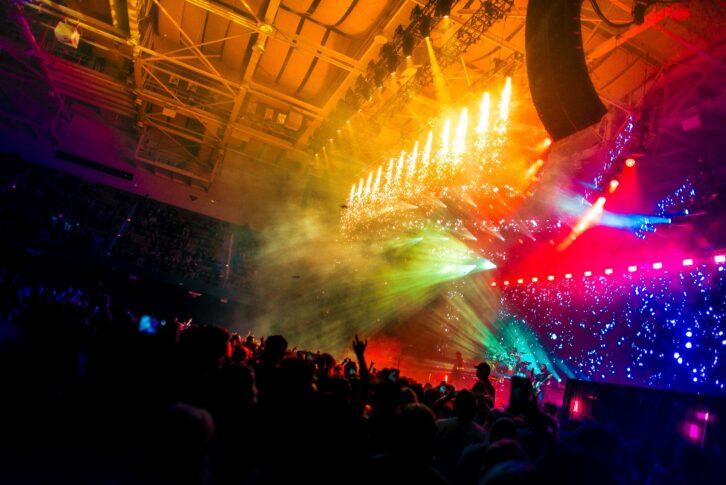
For heavy metal fans, one of this year’s highlights has been the Mega-Monsters tour, featuring Atlanta-based Mastodon and French metal masters Gojira rotating co-headlining slots. The tour spent most of the spring careening across the U.S. before both bands took a well-deserved break, but the rock resumes with more shows in August.
Tackling Mastodon’s mixes are Rob Lightner at front-of-house and Patrick Krause in monitorworld, while Gojira’s mix team includes FOH man Johann Meyer and monitor mixer Eric Shenyo. The tour marks Krause’s first tour with Mastodon, says Lightner, but the two engineers have known each other for some time: “I’ve been doing monitors longer than front-of-house, and Paddi is always going to be my first call when I need somebody to replace me. When he was available for this, I just instantly felt like things would be right. He’s very particular about things, and he’s very good at what he does.” Rounding out the crew are Bobby Brickman, handling system tuning duties, and monitor tech/RF coordinator Sam Schmitt.
For FOH engineers Lightner and Meyer, the tour has provided an opportunity to work together again, as the two bands have toured together before, and both engineers speak highly of each other.
“There’s a long history of us going back and forth with new ideas and influencing each other to try new things, and it’s always so well-received,” says Lightner of Meyer. “It’s not necessarily just sharing ideas with Waves; it’s sharing ideas and techniques throughout all audio aspects. The singer for Gojira doesn’t like low end on stage, and subs tend to couple on stage, so we just tried to talk about ways that we could supplement our low end with the sub configurations. I think we all really achieved a great balance of being able to keep it nice and punchy, but not focused in the center of the stage.”
Adds Meyer, “I think it’s super cool in the engineering world to share; I don’t really like calling it tricks or magic or whatever, but ideas, you know? In the digital world, we all use plug-ins and stuff, and sometimes you pull up a plug-in on the screen and you’re like, ‘Oh, what is this thing like?’ Like we named one the ‘Space Tube’—it’s a plug-in with a lot of things that we don’t really understand. ‘Okay, let me try this thing.’ I remember after he left, I texted him that I like this Space Tube; I think I’m going to buy it.”
Both front-of-house and monitors use Avid Venue S6L-32D consoles, provided—as is all the audio production on the tour—by DCR Nashville. They use the E6L engine and a Stage 32 to connect to outboard gear—and there’s quite a bit of that in the racks. Lightner uses an Eventide H3000 Ultra-Harmonizer, a Neve Portico II Master Buss Processor and an Empirical Labs Distressor at the FOH position.
“I’ve always really enjoyed a Distressor on the snare, and I use an Eventide H3000 for vocal effects,” says Lightner. “I have the Neve Portico II on my main bus. It’s something that I’ve recently started using, and I’ve been really excited about the results that it’s given me. It’s a nice feature to have, the Silk Red/Blue Texture controls, to just add a little bit of flavor to the overall mix.”
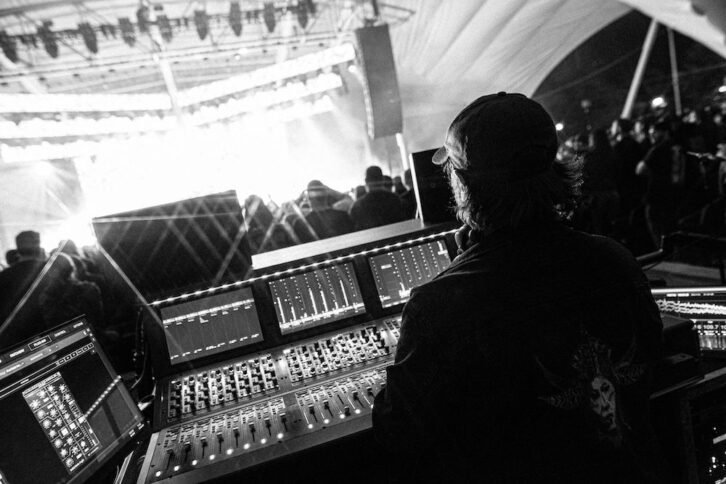
Meyer, meanwhile, sings the praises of his SSL compressor for outboard gear: “Mainly, I use an SSL Bus Compressor on my mix bus. That is something I’ve been using for a long time, I’m really used to mixing to it, and I lean pretty hard on it. I also have a Little Labs Voice of God, which is a weird thing that you don’t really see often—a frequency resonator. It’s going to boost the frequency and cut it at the same point so it’s just like a very sharp peak; it’s really cool for kick or bass to get a little more low-end to sound a little bigger. I also have a couple of Distressors and a couple of Yamaha SPX90 reverbs that I really love.”
Of course, the plug-in integration with the S6L is something that both Lightner and Meyer treasure. They use a Waves Titan server to handle all Waves plug-ins and feel that it has been incredibly powerful and stable for their needs.
“It reacts a lot faster than the older version,” says Meyer. “Obviously, it has more DSP, but I’m not maxing it out at all; I think I’m running at about 10 percent. Also, it’s unlimited power with this new Titan server. We did four weeks with no issues.”
The tour has been traveling with an L-Acoustics K2 line array system, running a total of 36 K2s, supplemented by Kara speakers for near-fields and 16 KS28s for subs, all powered by L-Acoustics LA12Xs.
Prior to going out, Meyer was a little unsure about using the K2, but found it passed the test with flying colors: “I’m very much used to the K1, the big one; I’ve used the K2 a few times in club shows and stuff, and in my head, I was like ‘K2 is for clubs.’ I was really surprised how loud and powerful it can be in an arena. We did the Kia Forum in L.A., which is a pretty massive venue, and we had absolutely no problem getting enough pressure and power, and there was still headroom available.”
Mixing The Iron Maiden ‘Legacy Of The Beast’ Tour
Lightner ascribes part of the smooth handling of the K2 array to Brickman’s talents. “Bobby was really good about working with us and trying to achieve everything that both Johann and I are trying to get out of the P.A.,” he notes. “It didn’t take him long to really figure out what makes us happy and how to how to achieve that every day. It’s been really a breath of fresh air to not have to worry and do my own EQ-ing on top of what the system already has. There’s only been a couple of nights here and there where I did any sort of adjustment to the overall EQ. That’s typical stuff that happens during the daytime versus when the show comes and people get in the venue, but Bobby was really on top of it.”
Both Lightner and Meyer use a combination of Box of Doom ISO boxes and DI signals for the guitar, while bass is strictly DI. For guitar DI, Meyer uses a Two Notes Torpedo speaker simulator that he blends with the signal from the Box of Doom, while Lightner uses a Radial.
Nearly everyone in both bands uses in-ears, though Gojira’s vocalist/guitarist Joe Duplantier and lead guitarist Christian Andreu supplement with wedges, and bassist Jean-Michel Labadie is only using wedges. Meanwhile, in the Mastodon camp, lead guitarist and singer Brent Hinds ditched IEMs early in the tour, according to Lightner: “Brent does not use in-ears. He’s tried it; he goes back and forth sometimes. He’s a very particular guy, and he seems to like just the old-school speakers on stage moving air. In fact, we started out the tour without any side fills, and he just felt that there was something missing without them.”
For all the history between the bands, there was surprisingly little collaboration on the first tour leg outside of Duplantier sitting in one night on Mastodon’s “Blood and Thunder,” but that looks likely to change when the tour resumes. “They’re very good friends, so they like to do that stuff,” says Meyer. “Backstage, we have a small drum kit and amps, practice stuff, and sometimes Brent from Mastodon pops in the Gojira dressing room and grabs a guitar.”
The second U.S. tour leg is right around the corner, too, as the bands and audio pros re-team in August. As Paul Owen, president of DCR Nashville, points out, “I have looked after Gojira and Mastodon for many years and it’s so good to see both of them out on a major tour together. I have had a long-standing relationship with this production team and engineers, and have always admired their approach; it’s a great-sounding tour.” Those sounds will continue as the next leg rolls into early September, to be followed by a South American run in November.
